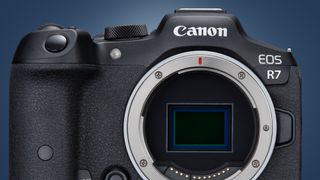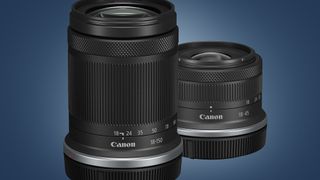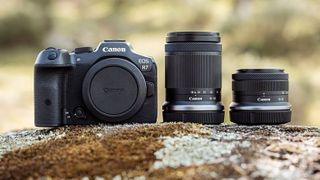Canon's new mirrorless cameras are winners with one big weakness
Opinion: Canon's new cameras have the 'electric car problem'

Canon's new mirrorless stars, the Canon EOS R7 and EOS R10, will probably be the biggest camera launches of the year. Not because they're the best ones it's ever made, but because they do something that hobbyists have been crying out for – bring Canon's latest mirrorless tech to cameras that most of us can actually afford.
Having spent a few hours in their company, I can confirm that the EOS R7 and EOS R10 will most likely be two of the best cameras around for hobbyists, and certainly two of the best Canon cameras you can buy. Their list of compelling features is long, including some impressive autofocus skills that scan scenes as relentlessly as a T-800 Terminator, locking focus onto the eyes of humans and animals from afar.
But both cameras also have a weakness that is nothing to do with their own considerable talents: lenses.
Glass roots
For two beginner-friendly cameras, the lens situation is painfully complicated. The EOS R7 and EOS R10 both have Canon's RF-mount. This arrived back in 2018 as a springboard for Canon's next-gen mirrorless cameras and was designed for full-frame sensors, because that's where the growth and excitement was (and still is).
But full-frame cameras are expensive and need larger lenses, making them less suitable for hobbyists. This is why the Canon EOS R7 and EOS R10 are here; they both have smaller APS-C sensors and allow Canon (like Sony and Nikon) to build one system, for all types of photographers and creators, around a single mount. Or that's the theory.

So what's the problem? The issue is that there's a disconnect between the type of lenses that are currently available for the RF-mount, and the types of photographers who'll buy the EOS R7 and EOS R10.
The whole point of these two new mirrorless cameras is that they combine Canon's latest tech with the benefits of APS-C cameras, which tend to be smaller, cheaper and good at shooting long-distance subjects like wildlife, due to their crop factor.
But the cameras can't do this on their own – they need a whole system of lenses that have been designed with the same benefits in mind. And right now, the Canon EOS R7 and EOS R10 don't have that.
Perfect partners
Canon is aware of this, which is why it introduced two new 'RF-S' lenses alongside its new mirrorless cameras. But these new launches – the RF-S 18-150mm f/3.5-6.3 IS STM and the wider RF-S 18-45mm f/4.5-6.3 IS STM – are pretty unexciting kit zooms.
That 'RF-S' name simply means these lenses have been designed for Canon's new APS-C cameras. They aren't the only lenses that work with the EOS R7 and EOS R10 – you can use existing RF and EF lenses (via an adaptor), too. But those new RF-S ones are the only two that have been custom-made for their smaller sensors, hence their price, size and versatile focal lengths.

To be fair, Canon does have some affordable, full-frame RF lenses that should work nicely with the EOS R7 and EOS R10.
The RF 35mm f/1.8 Macro IS STM would give you a 56mm equivalent focal length (making it close to a 'nifty fifty'), while the RF 50mm f/1.8 STM is a fine lens that could work very well with the EOS R10 for portrait, event or street photography. We're also looking forward to seeing how well the EOS R7 pairs with the RF 600mm f/11 IS STM for wildlife snapping.
But many of these cheaper full-frame lenses are larger than they need to be and often lack features like weather-proofing. After those select few lenses, it already starts to become slim pickings, and even those ones are slightly clunky solutions for two otherwise exciting cameras.
Anyone who's hoping for a wave of bright, compact prime lenses, like the ones you can get on Fujifilm's X-series, might be waiting for a very long time, if history is any guide.
Blast from the past
We've been here before and it isn't an issue that's exclusive to Canon. Nikon has perhaps already given us a glimpse of the fate awaiting the RF-S lenses for Canon's EOS R7 and EOS R10.
In the past few years, Nikon has released two lovely APS-C cameras in the Nikon Z50 and Nikon Z fc. But out of the 27 lenses that are available for its Z-mount, just three are designed for those cameras' smaller 'DX' sensors. Nikon's roadmap also contains just one more DX lens, the Nikkor Z DX 12-28mm, which has an unknown release date.
For those two Nikon cameras, and Canon's new ones, it's possible to use an adaptor to increase your options with older F-mount and EF-mount lenses that were made for DSLRs. But this is a stop-gap solution, not a long-term one. And it is something you should certainly consider before pre-ordering Canon's new cameras.

In some ways, the issue reminds me of the electric car problem. It's easy to get carried away with the acceleration and shiny features of today's EVs. But here in the UK, like many countries, the charging network simply isn't good enough to make the whole experience something that lives up to the cars themselves.
Right now, the Canon EOS R7 and EOS R10 have a similar issue. I'm hoping that Canon goes a lot further than Nikon in fleshing out its RF-S lens lineup. According to Canon Rumors, as many as five EF-S could be en route, though it isn't yet clear exactly when they'll land.
Not that it's a complete deal-breaker if they don't arrive soon – for many people, a mix of those two new kit lenses, Canon's smaller RF-mount primes, and some older EF-S glass via an EF-EOS R adapter will be more than enough for the kind of photography or video they enjoy.
But it does also feel that Canon's two impressive mirrorless cameras are, currently, a side-show to its full-frame plans. If the EOS R7 and EOS R10 are to truly realize their potential as small, affordable hobbyist cameras, they'll need some lenses to match.
Get daily insight, inspiration and deals in your inbox
Get the hottest deals available in your inbox plus news, reviews, opinion, analysis and more from the TechRadar team.

Mark is TechRadar's Senior news editor. Having worked in tech journalism for a ludicrous 17 years, Mark is now attempting to break the world record for the number of camera bags hoarded by one person. He was previously Cameras Editor at both TechRadar and Trusted Reviews, Acting editor on Stuff.tv, as well as Features editor and Reviews editor on Stuff magazine. As a freelancer, he's contributed to titles including The Sunday Times, FourFourTwo and Arena. And in a former life, he also won The Daily Telegraph's Young Sportswriter of the Year. But that was before he discovered the strange joys of getting up at 4am for a photo shoot in London's Square Mile.
